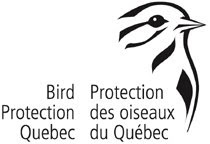Friday, January 04, 2013
Bird Protection Quebec's "Monthly Meeting/Lecture"
Date: Monday January 7, 2013
Time: 7:30 pm - 10:00 pm
Location: Knox Crescent Kensington and First Presbyterian Church 6255 Godfrey Avenue NDG
Notes: International Birding
Many of our members are ecotourists, travelling the world to see birds. We thought it would be interesting and fun to have them share their experiences and perhaps inspire more members to go globe-trotting. So this is the night.
INTERNATIONAL BIRDING
Nick Acheson: GETTING STARTED
I have been on birding trips in the USA ( Alaska, Texas, Montana, Arizona ) Australia, Antarctica and Ecuador and have enjoyed birding on my own at resorts in Mexico and Central America where we go for short respites from Montreal winters! International birding is great fun and I can give you some advice on how to get involved in such trips.
Jane Cormack: KENYA BIRDING SAFARI
A presentation featuring the highlights of of the 2012 birding safari in Kenya , led by David Bird and Rodger Titman. We visited a variety of sites including the famous Nairobi and Maasai Mara game parks and lesser known research and wildlife centres, covering habitats from the vast open savannah to the rich lakes of the Rift Valley to the flooded streets and traffic jams of Nairobi. Our accommodations covered the full gamut from rustic cabins with outdoor facilities to four and five star hotels. The wildlife did not disappoint. We saw the big five , some of the small five as well as flamingoes, ostrich, honeyguides, barbets and tinkerbirds, hornbills, hoopoe, kingfishers, bitterns ,pelicans, rollers, secretary birds and go-away birds.
Jean Demers and Clémence Soulard: BIRDING IN COLOMBIA
With approximately 1,900 bird species, 80 of which are endemic. we opted for a Colombian tour. For us, it's very important to hire local people and thereby help the local economy. We were in contact with Luis Eduardo Urena the director and owner of Manakin Nature Tours� http://www.manakinnaturetours.com for over a year before our vacation. We felt fortunate to find a tour operator who was very professional and worked hard to ensure that we saw particular birds. (He worked so hard that he found two lifers for himself!)
We travelled mostly in the mountains, between 300m and 4,000m. We started in Bogota (2600m) at Parque La Florida, and then drove to El Jard�n Encantado in San Francisco. The main attraction there was 28 Hummingbird feeders. In two hours, we counted 16 species including Long Bill Hermit, White-necked Jacobin, Brown Violetear and the magnificent Red-billed Emerald.
Martin Bowman: SOUTH KOREA AND HOKKAIDO, JAPAN'S NORTHERN ISLAND
South Korea is one of the most accessible places on the planet to see birds on migration from Siberia to southern Asia with the west coast of the country on the flyway of many interesting species. We were there in early October, our visit timed to see the Spoon-billed sandpiper and we were not disappointed. Hokkaido is Japan's wild northern frontier, home to the Red-crowned or Japanese Crane and the spectacular Blakiston's Fish-Owl; it is also the wintering grounds of the Steller's Sea -Eagle.The pelagic birding is amazing.
Eileen Meillon: ON THE FRENCH- SPANISH BORDER
The Parc national des Pyrenees is accessible from six valleys in the Hautes-Pyrenees department of the French-Spanish border. While the mountain scenery is magnificent, one can also see some of the world's largest raptors. The park has recently partnered with La Ligue pour La Protection des Oiseaux for the protection of some of them, including the Lammergeier. Smaller birds like the Alpine Accentor and the Rock Thrush also prefer a mountain habitat.
Virginia Elliott and Nancy Montgomery: THE GALAPAGOS
"Galapagos " has become synonymous with conservation. Elsewhere in the world environmentalists struggle to have the protection of habitat and animal species recognized as a priority . The Galapagos have become the focus of how to harmonize human impact and the natural world . It is a privilege to travel there , not only because there are unique species but to witness the positive effect that the worldwide attention on conservation has had.
The speakers have ten minutes for their presentation but you will be able to speak to them at the back of the room afterwards.
Subscribe to:
Post Comments (Atom)





No comments:
Post a Comment